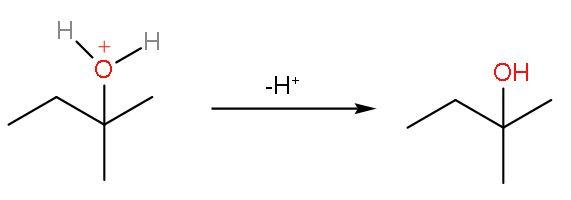Answer
435.6k+ views
Hint: Hydrolysis means the reaction of compounds with water. ${{\text{S}}_{\text{N}}}\text{1}$ mechanism mainly follows two to three steps, formation of carbocation, followed by shifting of positive charge and then deprotonation of nucleophile. It is a nucleophilic substitution reaction.
Complete step by step answer:
Let us find the final product using ${{\text{S}}_{\text{N}}}\text{1}$ mechanism:
Step (1)- The carbon-bromine bond is polar because of the difference in electronegativity of the elements. Bromine is more polar than carbon. So, the bond breaks to form the carbocation and the leaving group will be bromide ion.

Step (2)- The positive charge on the carbon is shifted as there can be formation of more stable carbocation. The stability of a carbocation seen by hyperconjugation effect. The more the number of hyper conjugating structures the more will be the stability of carbocation. This carbocation has 4 $\alpha -$hydrogens. Hyper conjugating structures are counted by counting the number of $\alpha -$hydrogens. So, there will be hydride shift or shifting of hydrogen atom.

This is more stable as it has 6 $\alpha -$hydrogens.
Step (3)- Attack of nucleophile that is water on the carbocation, so, oxonium ion is formed. There will be positive signs on electronegative oxygen atoms.

Step (4)- The positive charge on the oxygen atom is removed as ${{\text{H}}^{+}}$ ion gets removed from the attached water molecule. The final product formed will be 2-methyl-2-butanol.

The correct answer is option ‘b’, 2-methyl-2-butanol.
So, the correct answer is “Option B”.
Note: The role of solvent is very important for ${{\text{S}}_{\text{N}}}\text{1}$ reaction. The preferred solvents for ${{\text{S}}_{\text{N}}}\text{1}$ reaction are both polar and protic solvents. The polar nature of the solvent helps in stabilizing the ionic intermediates formed whereas the protic nature of the solvent helps to solvate the leaving group.
Complete step by step answer:
Let us find the final product using ${{\text{S}}_{\text{N}}}\text{1}$ mechanism:
Step (1)- The carbon-bromine bond is polar because of the difference in electronegativity of the elements. Bromine is more polar than carbon. So, the bond breaks to form the carbocation and the leaving group will be bromide ion.

Step (2)- The positive charge on the carbon is shifted as there can be formation of more stable carbocation. The stability of a carbocation seen by hyperconjugation effect. The more the number of hyper conjugating structures the more will be the stability of carbocation. This carbocation has 4 $\alpha -$hydrogens. Hyper conjugating structures are counted by counting the number of $\alpha -$hydrogens. So, there will be hydride shift or shifting of hydrogen atom.

This is more stable as it has 6 $\alpha -$hydrogens.
Step (3)- Attack of nucleophile that is water on the carbocation, so, oxonium ion is formed. There will be positive signs on electronegative oxygen atoms.

Step (4)- The positive charge on the oxygen atom is removed as ${{\text{H}}^{+}}$ ion gets removed from the attached water molecule. The final product formed will be 2-methyl-2-butanol.

The correct answer is option ‘b’, 2-methyl-2-butanol.
So, the correct answer is “Option B”.
Note: The role of solvent is very important for ${{\text{S}}_{\text{N}}}\text{1}$ reaction. The preferred solvents for ${{\text{S}}_{\text{N}}}\text{1}$ reaction are both polar and protic solvents. The polar nature of the solvent helps in stabilizing the ionic intermediates formed whereas the protic nature of the solvent helps to solvate the leaving group.
Recently Updated Pages
When people say No pun intended what does that mea class 8 english CBSE

Name the states which share their boundary with Indias class 9 social science CBSE

Give an account of the Northern Plains of India class 9 social science CBSE

Change the following sentences into negative and interrogative class 10 english CBSE

Advantages and disadvantages of science

10 examples of friction in our daily life

Trending doubts
Fill the blanks with the suitable prepositions 1 The class 9 english CBSE

Which are the Top 10 Largest Countries of the World?

Difference between Prokaryotic cell and Eukaryotic class 11 biology CBSE

Differentiate between homogeneous and heterogeneous class 12 chemistry CBSE

10 examples of evaporation in daily life with explanations

One cusec is equal to how many liters class 8 maths CBSE

Give 10 examples for herbs , shrubs , climbers , creepers

Difference Between Plant Cell and Animal Cell

How do you graph the function fx 4x class 9 maths CBSE



